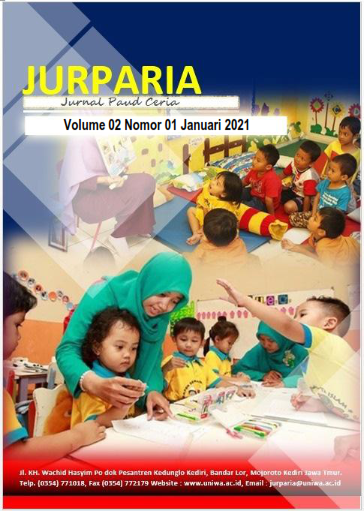MENGEMBANGKAN KEMAMPUAN MOTORIK KASAR ANAKMELALUI PERMAINAN KARTU BALON CERIA PADA ANAK USIA 3-4 TAHUN DI PAUD TUNAS HARAPAN BENDO KABUPATEN TULUNGAGUNG TAHUN AJARAN 2019/2020
Keywords:
Gross Motoric, Cheerful Balloon CardsAbstract
Early Childhood is a unique individual who has a pattern of growth and development in physical, cognitive, social, emotional, language creativity and specific communication in accordance with the stages the child is going through. Gross motor activity is the movement of various parts of the body at the behest of the right brain and left brain and regulates body movements against various external and internal influences. This gross motoric skill is very important for someone to have because they usually do daily activities, without having good motion they will be left behind by others, such as: running, jumping, pushing, throwing, catching, kicking and so on, these activities require and use coordination of the large muscles in one's body. Playing the cheerful bolon is also closely related to the gross motor skills of children in coordinating the muscles in the child's body, so that the child can make a movement that can balance the body and coordinate with the brain. Through this method of playing balloons, children can train their balance optimally. PAUD Tunas Harapan Bendo, Gondang Subdistrict, Tulungagung Regency, has 5 students, who are still underdeveloped in gross motoric movements. So the researchers compiled this thesis which aims to improve children's gross motor skills in the fun balloon card game. This research is a classroom action research. The results showed that the gross motor skills of children in terms of being able to understand commands, being able to carry out orders and succeeding in carrying out orders in PAUD Tunas Harapan pre-cycle stage was 20%, children began to develop in terms of being able to walk following orders and began to develop in terms of children being able to walking with the help of teacher guidance gets a percentage of 40% and the child begins to develop in the case that the child has started to be able to walk alone without assistance getting a percentage of 20% of 5 children. In the first cycle of 40%, the child begins to develop in terms of the child being able to walk according to orders and the child develops according to expectations in terms of the child being able to walk with the help of the teacher's guidance getting a percentage of 60% and the child begins to develop in the case that the child is able to walk alone without getting help a percentage of 40% of 5 children. In cycle II, 60% of children developed according to expectations in terms of being able to walk according to orders, children had started to be able to walk with the help of teacher guidance to get a percentage of 80% and children developed according to expectations in terms of being able to walk alone without assistance by 80% of 5 students PAUD Bendo
Downloads
Downloads
Published
Issue
Section
License
Copyright (c) 2021 JURPARIA

This work is licensed under a Creative Commons Attribution-NonCommercial-ShareAlike 4.0 International License.




















